We travelled to Tanzania from Curacao via Amsterdam to Kilimanjaro Airport.
Tanzania obtained its indenpendence from Great Britain in early 1960’s. It is made up of Tanzania and Zanzibar. It became an indenpendent republic in 1964 and is East Africa’s largest country. Their currency is the Tanzanian Shilling (1 US dollar =2,306 TZS) They prefer commerce in US dollars.
The population (2020) is 58,552,845, with lowest population density. A third of the population live in urban areas. Broken down, 99% African (95% Bantu with over 150
Tribes). The fertility rate is 4.8/woman. The average age at childbirth is 19. Life expectancy for women is 65, men 62. Two thirds of the population is less than 25 years old.
There is excessive morbidity due to AIDS and an increased infant mortality rate.
Religious beliefs: 61% Christian and 35% Muslim on the Mainland. Zanzibar religions all seem to let individual faiths exist without interference.

We arrived in Mt. Kilimanjaro Airport late Jan 10 and after receiving our visas were shuttled to the Mt. Kilimanjaro View Lodge where we enjoyed the views and got rested after a long flight from Caracao via Aruba and Amsterdam. We arranged for a pick up to the lodge and would never have found it otherwise.
We were tired and we rested quite well in a typical “hut” with shower and communal dining facility. Past 3 days “off grid” (no WiFi, no cell, no A/C, no heat, some electric) in foothills of Mount Kilimanjaro, which, at about 6000m (18000ft), is highest peak in Africa.
Kilimanjaro, at about 3 Deg S of equator and is snow-covered year around. We hiked at 2000m, and that was enough elevation! The forest is delightful.
The Swahili People in the foothills are delightful, friendly, smiling, soft-spoken, and industrious. They would be assets to whichever country they might immigrate. We hope some of them choose Canada.
Swahili is spoken in the remote villages with only a bit of English, so to help communication we are learning Swahili. We know about 50 words, most importantly including taffadali (please), Asante sana (thank you), jambo bwana (hello senior male).
And then there is, mzee mzugu poli poli babu (old white slow grandfather).
The children we met were very excited to receive small Canadian Flag 🇨🇦 lapel pins.
We stayed for 3 days before joining our OAT tour. We employed a young man who guided us on a walking tour all around the countryside.
We learned some Swahili and were welcomed warmly wherever we went.
We visited a small coffee production and learned the multi-step labor intensive process, made easier with singing!

BiBi is the name for grandmother and this one was quite old. Peter gave BeBe Canadian pins.
Women work hard carrying bundles of greens for their animals.
We were treated to a traditional dance and singing performance in our lodge.
Mt Kilimanjaro on a clear day!
Beautiful hydrangeas at the Lodge
Cottage industry Front porch kanga business with lovely fabric designs.
Children enjoyed their pictures being taken
We join our Overseas Adventure Travelers on Jan 13 in Arusha’s Moshi Lodge. We are a group of 3 couples and 10 ladies. Our trip leader was Haji and two very knowledgeable naturalists (Daniel and David) and another in Zanzibar (Samuel).
We walked the neighborhood and were befriended by the community.
Our Moshi Lodge Suite
Our trip would start in Tarangire National Park for 2 days, followed by a day in the Maasai Village, then we visited Olduvai Gorge and travelled to Serengeti National Park where we spent 4 days in a Tented Safari. Then we visited Ngorongoro Crater and Highlands for 2 days and returned to Arusha.
They provided translations with the Maasai and suggestions as to where we could find special gifts.
We enjoyed tribal encounters with the Maasai and nomatic Bushmen who wonder throughout the countryside guarding their animals.
We enjoyed tribal encounters with the Maasai and nomatic Bushmen who wonder throughout the countryside guarding their animals.
Jumping Dance
We did our touring in three Range Rovers. The roofs were raised and we stood on the seats when a siting occurred. Hagi and his two fellow naturalists Were great sighters as was Catherine who was first to see father babysitting about 6 cubs while the lioness were hunting.
We would pull over when an educational moment presented itself, an outdoor market, Masi women travelling with jugs and donkeys for water, a card game which we were invited to join.
We travelled on very rough terrain and inevitably, there were times when we were stuck and needed a pull from another Jeep and our three strong young men changed a tire. we were far from civilization and were forbidden to leave the Jeep.

We were welcomed in a village and dressed in traditional jewelry and kangas.
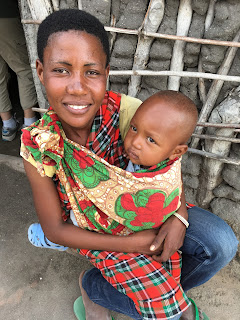



We learned how to make jewelry, dance, repair grass roofs, and some drank blood from cattle mixed with a “yogurt-type liquid.


We visited schools, Albino Protective Industries and Maassai tribes. Wherever we stopped, we were invited to ask questions, enter homes, and share home made liquor.


It is the custom that children come to school in uniforms. They walk to and from each day and carry water and some type vegetable. The water is quite cloudy because it is taken from streams. Each class uses a water filter. The vegetables are used for a soup which schools provide.
Cottage industry ceramic filter with 1.3 microns pores and charcoal
intermediate layer. Removes taste, sediment and 99.9% of pathogens. Flow 1
to 4 litres/hour. Produced from local materials except for tiny bit of
colloidal silver imported. The silver colloid absorbs and kills pathogens.
Life 5 years. Retail $40 US. Small company (40 employees) producing 6000 units/year.
Before and after filter ing process
Our group decided to make donations to purchase three water filter systems and distribute them where it could best be used.
Our team gave the instructions for use through a translated.
We learned about the Maasai tribe construction and extended polygamous family. So what was taught to The First wife upon presenting the water filter will be shared with the extended family.
We visited a school and two classrooms where we had the opportunity to chat with students in upper classes about their hopes for future education. We enjoyed their songs and they appeared to enjoy our “hokey Pokey”.
We travelled to Olduvai Gorge, made famous by the discovery of our human origins (Louis and Mary Leakey) and studies are still being conducted. It is one of the most important paleoarthrologic sites in the world.
We were impressed with the exhibits and information presented there. It has been concluded that Africa was the place for human evolution with the discovery of hundreds of fossilized bones and stone tools dating back millions of years.


We were awed by the abundance of large animals roaming the Ngorongoro Crater. The Crater is home to over 20,000 large animals.


Migrating Wildebeests
Tawny Eagle
American Eagle
The Highlights of this tour were the 4 UNESCO sites, the game drives in Ngorongoro Crater, Tarangire and Serengeti National Parks, Maasai and Mto Wa Mbundu. Illages, the Bushmen Esperience, Olduvai Gorge and the Safaris.
The Big Five include elephant, lion, leopard, buffalo and rhinoceros. They were indeed magnificent and we were so fortunate to see so many and so close.


Elephants under the famous Baobab tree which the elephants use to scratch their backs.



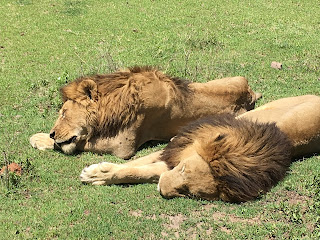


The Big Five include elephant, lion, leopard, buffalo and rhinoceros. They were indeed magnificent and we were so fortunate to see so many and so close.


Elephants under the famous Baobab tree which the elephants use to scratch their backs.









The Masai Mara, Tarangire and the Serengeti are the most famous game Parks in the world and home to the greatest wildlife migration on earth.
We followed herds of elephants, lions, rhinos and giraffes as well as wildebeest, zebras and gazelles roam the Serengeti savannahs and cross crocodile-infested rivers and are hunted by lions, leopards, and cheetahs in search of greener pastures. The primeval savannah of baobab trees are filled with roaming herds of elephants and an array of predators.
Gazelles
Tanzanian Leaopard Tortoise
Terrific text with fauna description and photos.
Mother and young Zebra

Warthog Family
Dwarf Mongoose feeding on termite hill
African Crown Crane
Velvet Monkey Family
Fresh lion tracks
Giraffe
Lion atop a Termite Hill
Resting in the shade of our Jeep
Father Rajabu,
Almost Last Black Rhinos Before Extinction
Game Warden presents the Efforts for Preventing Extermination of the Black Rhino
There were opportunities to ride in hot air balloons to watch the migrations.
Marabou stork

Hyenas are too plentiful and preventing other animals from hunting
Common Waterbuck
OUR SAFARI TENT ACCOMMODATIONS
We were warned not to leave our tent site without a guide at night.
Gourmet meals each night
A surprise birthday celebration!
Our waiter and chef! We even had a cooking lesson.
And of course there were local beers!
Bush Television
Hippopotamus
Kori Bustard
Secretary Bird
Impala
After a kill
Cheetah or Leopard?
Cheetahs are the fastest mammal alive. They are much leaner and capture their prey by tripping it.
Cheetahs have spots and black tear-like markings. They have non-retractable claws. Cheetahs are diurnal.
Leopards are much heavier build and stalk their prey for long periods. Leopards are nocturnal and have retractable claws. Both cheetahs and leopards climb trees. Leopards wait until they are close to their prey before attacking. They are strong enough to carry their prey up the tree (protects against hyenas).

ARUSHA
Woodcarvers of ebony and main go wood
Cotton dyed with indigo
Wood carving is an inherited art here.
Tanzanite found only in Tanzania, a blue violet mineral zoisite
We visited an art community for handicap who were busy dying, painting, weaving using very primitive band unique equipment, such as the bicycle wheel used to spin cotton. Small glass beads made in glass blowing shop
We visited an Albino Protection Shelter and were given an education about the killings and amputations of albinos in the 2000’s. We supported the educational program by buying crafts made by people living in the shelter to counter the mis-information provided by the Medicine Doctor.
Peter took a turn sanding ebony at a woodcarving Center. We bought a few souvenirs.
ZANZIBAR POST TRIP
There were 8 travellers who joined us in Zanzibar for the post trip experience. Zanzibar is an archipelago 23 miles from Tanzania mainland in the Indian Ocean. We travelled there in a small plane to Stonetown. It became independent in 1963 and is now part of Tanzania. It was known as the slave and “spice island”. Today it is almost entirely Muslim.
Stonetown was designated a UNESCO Cultural Heritage Site in 2000. The streets are filled with minarets, carved doorways and landmarks such as the Sultan’s Palace. It is a big trade Center with Islamic and Swahili influences. People here are friendly and like to exchange greetings.
African Ugali or Indian Chapatti, a favourite!
Giant jack fruit
Lychees
Red Colobas Monkey in the Jazani Forest
Luxurious accommodations
Sail to island and Picnic
We had a delightful cruise on a sailing Dhow to Prison Island
We enjoyed the local music and sharing caps
Nice picnic and swimming in cooling Indian Ocean
And there was a second surprise birthday complete with singing by the kitchen, wait staff and tour guides.
Wonderful staff at our beach resort
A visit to the Spice Farm, complete with new head apparel
pepper plant
A visit to our local guide, Samuel and family
What a journey! Definitely a place to behold!

Many thanks to Jerry, Lois and other OAT travelers for their photos!



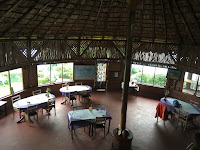
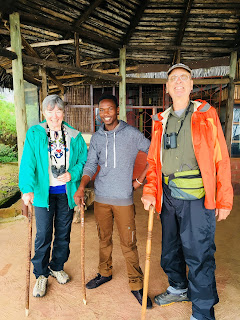

















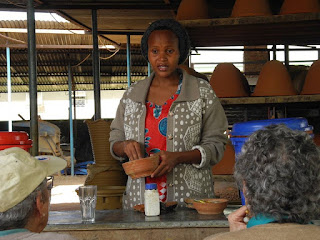















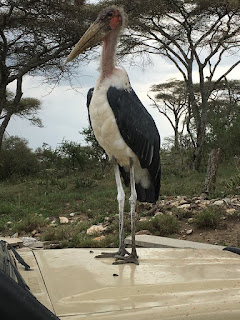
















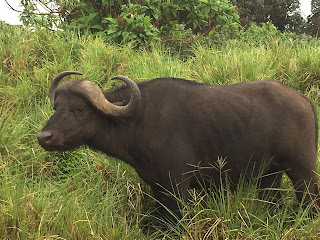































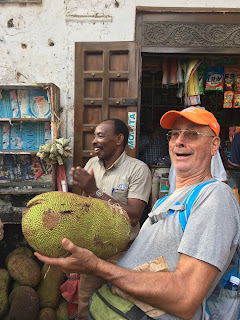
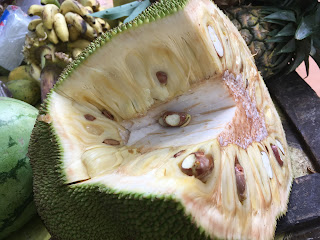















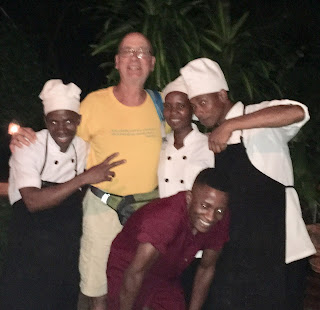



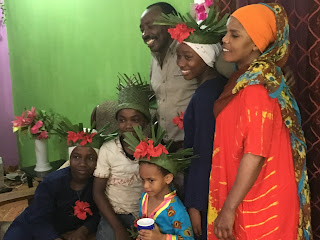

No comments:
Post a Comment